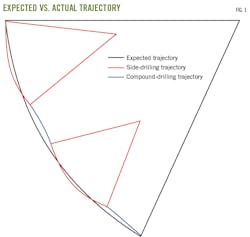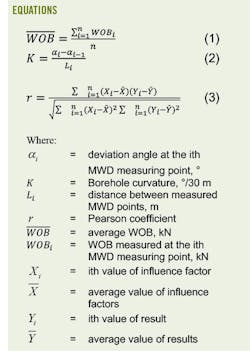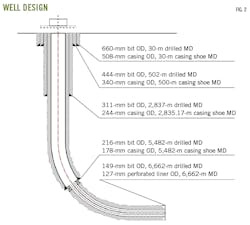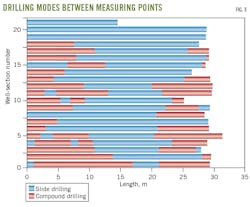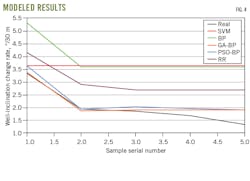Compound drilling model predicts wellbore trajectory
Tiansheng Deng
Qian Li
Hu Yin
Southwest Petroleum University
Chengdu, China
A slide and compound drilling model calculates build-up rate (BUR) of a single bent-angle motor assembly using a physical model and genetic-algorithm back propagation (GA-BP) regression analysis. This method predicts well trajectory in the next drilling stage, improving trajectory quality and drilling efficiency. It can also aid machine learning or artificial intelligence control of well trajectory.
Trajectory control
Borehole trajectory controls well direction and horizontal well construction. Smooth trajectory supports steady weight-on-bit (WOB) application and efficient and accurate adjustment of the tool face. When well trajectory deviates from the predetermined path, the bit deflects from the expected position. The operator cannot make immediate corrections to these deviations because trajectory data contain hysteresis from a several-meter gap between the trajectory measuring device and bit. If allowed to build up, these deviations could require large trajectory corrections in later-stage drilling, requiring major expenditure of time and effort and still not guaranteeing that well trajectory will meet expectations.
Drilling trajectory and efficiency improve with accurate prediction of bottom-hole assembly (BHA) BUR for next-stage wellbore trajectory. Theoretical research and drilling practices show that BHA BUR is mainly affected by BHA geometric structure and mechanical properties, drilling operation parameters, borehole geometric parameters, formation parameters, and bit parameters.1 There is no universal mathematical or mechanical model to accurately reflect the functional relationship between BUR and these factors.2
The BUR variation of a bent-housing motor in slide drilling is small. In the process of directional drilling, slide drilling and compound drilling are carried out alternately to extend the trajectory along the expected track (Fig. 1). The proportion of slide drilling and compound drilling, and switching scheme between the two, needs to be determined in advance, which requires an experienced operator. An improper proportion and switching scheme will reduce the quality of borehole trajectory and drilling efficiency. There is no research on prediction of BUR under combined modes of slide drilling and compound drilling.
This work models well-trajectory control of a bent-housing motor to predict BUR when slide drilling and compound drilling are carried out alternately. These predictions will reduce dependence on operator experience and provide guidance for intelligent control of well trajectory.
Previous studies have predicted drilling performance. Hasan et al. proposed an approach to predict drilling rate with genetic algorithm (GA) and general regression neural networks (GRNN).3 Khosravanian et al. proposed a fuzzy-logic model for predicting drilling rate-of-penetration (ROP), which has been applied in Kinabalu oil field Malaysia and Ahvaz oil field Iran (OGJ, May 7, 2016, pp. 58-61) Chao et al. proposed a modeling method to determine the ability to drill a particular formation based on an online sequential nadaboost extreme-learning machine algorithm, which served as the online geological model to develop intelligent drilling systems.4 Geekiyanage et al. developed software-hardware architecture and algorithms for a laboratory-scale intelligent drilling rig which can optimize the drilling rate using real-time sensor data, classify formations, and mitigate drilling incidents.5 Chang et al. trained, verified, and tested seven main monitoring parameters and two-control signal data related to WOB with a neural network algorithm, mapping relationships between monitoring parameters and control signals, establishing closed-loop control system of WOB, and obtaining intelligent control of WOB.6 Saurabh developed a data-driven modeling approach for selecting the optimum bit type using response surface methodology (RSM) and artificial bee colony (ABC), which can automate drillbit selection, minimize human error, and reduce drilling cost.7
For deep and ultradeep formations, Wu et al. proposed a global closed-loop servo control intelligent drilling method which integrates rotary steering, geosteering, seismic while drilling, far-field electromagnetic measurement, measurement while drilling (MWD), signal transmission, automatic drill rigs, and other technologies. The random-forest algorithm and long short-term memory (LSTM) recurrent neural networks were used to evaluate porosity, permeability, saturation, and shale content to predict and optimize penetration rate.8 Tewari et al. proposed an automatic data-driven bit-type selection method for drilling the target formation based on optimum ROP, which has a 95% confidence level.9
Prediction of BHA BUR includes the geometric prediction method, mechanical prediction method, and regression analysis prediction method. The geometric prediction method uses the double radius and three-point definite circle methods.10-12 Since it was proposed in 1985, the three-point definite circle method was improved by Shuai et al., Tang et al., and Liu et al.13-16 The geometric prediction method only considers the BHA’s geometric structure, including the size of the bending angle or eccentricity, stabilizer factor (number, outer diameter, and position in the BHA), and geometric contact relationship between the BHA and the well wall. The geometric prediction method is simple and applicable to the geometric structure optimization of the BHA, but generally has a large error when applied in the field.
The mechanical prediction method mainly uses equilibrium curvature and ultimate curvature methods.17-19 The equilibrium curvature method holds that bit lateral force will gradually decrease during directional drilling, and when bit lateral force is zero, the corresponding wellbore curvature is the equilibrium curvature. Based on the equilibrium curvature method, the ultimate curvature method introduces two coefficients to correct the influence of tool face accuracy and formation factors on BUR prediction results.
As the purpose of the mechanical prediction method is to analyze the relationship between bit lateral force and BUR, it considers BHA structural parameters (position and size of bending angle, position and OD of stabilizer, and drilling-tool stiffness), process parameters (such as WOB), and wellbore geometric parameters (well deviation angle and borehole diameter).
The method of regression analysis prediction is statistics based, using actual drilling data to carry out statistical analysis, establish models, and then predict BUR. Wang et al. established a BUR prediction model related to five factors (bit lateral force, bit deflection angle, bit resultant angle, and BUR of the drilled section) by using a first-order linear regression method.20 Liu et al. used the orthogonal regression analysis method to predict the BUR.21 Based on reference data, Zhang et al. proposed a new method using a Kriging-agent model to predict BUR.22 Results show that prediction accuracy is higher than that of the common multiple regression model and radial basis function model (RBF). Qiu et al. predicted BUR with a method based on a backpropagation neural network (BP) optimized by genetic algorithm.23 Results show that prediction accuracy of this method is better than support vector regression (SVR), ridge regression (RR), radical basis function neural network, and other machine learning methods. GA-BP, therefore, is used in this work.
BUR prediction
The purpose of the ultimate curvature method is to analyze the relationship between bit lateral force and BHA BUR. The methods to calculate bit lateral force mainly include finite element analysis and the continuous beam method.24 25 Continuous beam accurately describes the quantitative relationship between structural parameters of the BHA, WOB, inclination angle, borehole diameter, and bit lateral force. There is no mathematical or physical model, however, to combine factors such as bit and formation with bit lateral force to predict BUR. Regression analysis is good at building relationships between elements that are not mathematically or physically related, but increasing the number of elements will reduce prediction accuracy. Therefore, this article adopts both physical modeling and regression analysis to predict the BUR of a single bent-angle motor assembly under mixed slide-compound drilling.
The lateral bit force is first calculated by the continuous beam method to obtain the ultimate curvature of the BHA. Results of this physical model are used as the basic data, and regression analysis adds factors not considered by the physical model to predict final trajectory. Field data need to be preprocessed before being used in the physical model. WOB constantly changes during the drilling process, and average logging data can be used for WOB in the continuous beam method, as shown in Equation 1. For a two-dimensional borehole, the borehole curvature between two MWD measurement points can be calculated by Equation 2.
BUR prediction under combined modes of slide drilling and compound drilling with a single bent-housing motor proceeds as follows:
- Segment the borehole according to MWD single-point measurement data.
- Determine the proportion of slide drilling and compound drilling in each section from torque and rotational speed data in the mud log.
- Calculate average WOB in mud-logging data during slide drilling and compound drilling in each section, respectively.
- Find the average WOB obtained in Step 3 as base data. Calculate bit lateral force and ultimate curvature for slide drilling and compound drilling in each section by using the continuous beam method and ultimate curvature method.
- Using the GA-BP method, combine the bit lateral force and ultimate curvature obtained in Step 4 with regression-analysis influencing factors to predict BUR.
Field results
A two-dimensional horizontal well study in Sichuan basin, China, explored the relationship between BUR and influencing factors, especially the slide-drilling proportion factor. The wellbore is shown in Fig. 2. The same BHA and bit were used in the 4,868.86-5,458.83 m section. Table 1 shows wellbore trajectory data measured by MWD and mechanical parameters calculated by the continuous beam and ultimate curvature methods. Specific conditions of slide drilling and compound drilling between the two measured points are shown in Fig. 3. For a similar formation, the deviation angle and borehole curvature of the front section can characterize the relationship between the formation and BUR. Factors affecting prediction of build-up slope include well deviation angle, front BUR, slide-drilling bit lateral force, slide-drilling ultimate curvature, compound-drilling bit lateral force, compound-drilling ultimate curvature, and slide-drilling proportion.
After selecting influencing factors, Pearson correlation coefficient analysis explored the correlation between each influencing factor and the predicted results using Equation 3. Pearson correlation coefficients are shown in Table 2. The Pearson value of slide drilling proportion is 0.7229, which is the largest among the seven selected parameters and proves significant correlation between slide-drilling proportion and BUR.
Taking input and BUR as influence factors between the two measuring points as the output, the GA-BP algorithm builds the prediction model. During model building, the previous 16 groups of data were used as training sets, and the last five groups were used as validation sets. To test GA-BP inclination accuracy, GA-BP predictions were compared with field data and BP, back-propagation neural network optimized by particle-swarm optimization (PSO-BP), SVM, and RR models (Fig. 4). Table 3 shows model prediction comparisons to measured MSE. The GA-BP method produced the most accurate wellbore trajectory prediction and lowest deviation between predicted and actual MSE.
Slide drilling proportion had a significant impact on BUR prediction. Predictive BUR GA-BP algorithm influencing factors include well-deviation angle, front BUR, bit lateral force of slide drilling, ultimate curvature of slide drilling, bit lateral force of compound drilling, ultimate curvature of compound drilling, and proportion of slide drilling. This method can also provide an algorithm basis for intelligent control of well trajectory.
At present, the method only includes well-deviation angle and front BUR as influencing factors when including bit and formation interactions. Additional bit and formation data will be required to extend that part of the model.
Acknowledgement
The presented study was supported by the National Key R&D Program of China (Grant No. 2019YFA0708302).
References
- Hong, Z., Yiliu, T., Lei, S., Chang, L.,Ding, F., and Yijing, F., “Research on Influential Factors of Build-up Rate and Prediction Method,” Journal of Oil and Gas Technology, Vol. 38, No. 4, January 2016, pp. 80-89.
- Hong, Z., Ding, F., and Shizhong, W., “A New Predicting Method of Build-up Rate of Steering Tools Based on Kriging Surrogate Model,” Arabian Journal for Science and Engineering, Vol. 43, No. 9, September 2018, pp. 4949-4956.
- Hasan, B.M., Aboozar, B., and Hamidreza, M., “Intelligent Drilling Rate Predictor,” International Journal of Innovative Computing Information and Control, Vol. 7, No. 4, April 2011, pp. 1,511-1,519.
- Chao, G., Weihua, C., Min, W., Xin, C., Yule, H., Guojun, W., Hui, G., Fulong, N., and Huafeng, D., “An Online Modeling Method for Formation Drillability Based on OS-Nadaboost-ELM Algorithm in Deep Drilling Process,” IFAC PapersOnLine, Vol. 50, No. 1, July 2017, pp. 12886-12891.
- Geekiyanage, S.C.H., Loeken, E.A., Wikjorski, E., and Sui, D., “Algorithms & Architecture for a Smart Drilling Rig,” Oil Gas European Magazine, Vol. 45, No. 1, 2019, pp. 24-25.
- Jianghua, C., Hongliang, T., Yang, Z., and Dong, F., “Research on Adaptive Control Method of WOB for Truck-mounted Drilling Rig,” IEEE International Conference on Artificial Intelligence and Information Systems (ICAIIS), Dalian, China, Mar. 20-22, 2020.
- Joshi, S., Bajpai, S., and Jana, S., “Application of ANN and RSM on Fluoride Removal Using Chemically Activated D. Sissoo Sawdust,” Environmental Science and Pollution Research, Vol. 27, No. 15, May 2020, pp. 17717-17729.
- Siyuan, W., ShouDing, L., Dong C., Xiao, L., Aimin, D., and Ying, Z., “An Intelligent-while-drilling Steering Method of Global Closed-loop Servo Control,” Chinese Journal of Geophysics, Vol. 64, No. 11, Nov. 1, 2021, pp. 4215-4226.
- Tewari, S., Dwivedi, U.D., and Biswas, S., “Intelligent Drilling of Oil and Gas Wells using Response Surface Methodology and Artificial Bee Colony,” Sustainability, Vol. 13, No. 4, Feb. 2, 2021, p. 1664.
- Hassen, B.R. and Macdonald A.J., “Field Comparison of Medium- and Long-Radius Horizontal Wells Drilled in the Same Reservoir,” SPE-19986-MS, SPE/IADC Drilling Conference, Houston, Tex., Feb. 27-Mar. 2, 1990.
- Karlsson, H. and Brassfield, T., “Performance Drilling Optimization,” SPE-13474-MS, SPE/IADC Drilling Conference, New Orleans, La., Mar. 5-8, 1985.
- Karlsson, H., Cobbley, R., and Jaques, G.E., “New Developments in Short-, Medium-, and Long-Radius Lateral Drilling,” SPE-18706-MS, SPE/IADC Drilling Conference, New Orleans, La., Feb 28-Mar. 3, 1989.
- Jian, S., Yongnan, Y. and Xuefu, H., “Build-up Rate Calculating on Short Bent Housing Motor,” Oil Drilling and Production Technology, Vol. 18, No. 1, 1996, pp. 4-10.
- Xueping, T., Zuxi, C., Guangtai, W., and Zili, G., “Study on Prediction Methods of Build-up Rate of PDM with Bent Housing for Middle-short Radius Horizontal well,” Drilling and Production Technology, Vol. 23, No. 3, 2000, pp. 13-18.
- Xiushan, L., Shushan, H., and Ye, Z., “Study on the Geometric Build Angle Rate of Steerable Motor,” Acta Petrolei Sinica, Vol. 25, No. 6, 2004, pp. 83-87.
- Xiushan, L., “Improved Method Evaluates Deflection Performance of Bent Housing Motors,” Oil and Gas Journal, Vol. 103, No. 12, March 24, 2005, pp. 42-46.
- Birades, M. and Fenoul, R., “A Microcomputer Program for Prediction of Bottomhole Assembly Trajectory,” SPE Drilling Engineering, Vol. 3, No. 2, 1988, pp. 167-172.
- Birades, M. and Gazaniol, D., “ORPHEE 3D: Original Results on the Directional Behavior of BHA’s With Bent Subs,” SPE-19244-MS, SPE Offshore Europe, Aberdeen, Sept. 5-8, 1989.
- Yinao, S., “A Method of Limiting Curvature and its Applications,” Acta Petrolei Sinica, Vol. 18, No. 3, Jul. 25, 1997, pp. 110-114.
- Junliang, W. and Chuanguang, D., “Regression Analysis and Application of the Build-up Rate of Drilling Assemblies,” Oil Drilling and Production Technology, Vol. 14, No. 1, 1992, pp. 25-30.
- Gonghui, L., Wei, L., Zhong, L., and Zhenjiang, W., “Predicting Build-up Rate of Drilling Tool by Orthogonal Regression Method with Four Factors and Three Levels,” Journal of Oil and Gas Technology, Vol. 32, No. 3, 2010, pp. 108-112.
- Hong, Z., Yiliu, T., Ding, F., Lei, S., Chang, L., and Qiaolei, S., “Research on Prediction Method of Build-up Rate of Deflecting Tools Based on Kriging Surrogate Model,” Science Technology and Engineering, Vol. 17, No. 3, 2017, pp. 61-68.
- Wangde, Q., Guojun, W., and Haojie, L., “A Back-Propagation Neural Network Model Based on Genetic Algorithm for Prediction of Build-Up Rate in Drilling Process,” Arabian Journal for Science and Engineering, April 2021, pp. 1-11.
- Jiazhi, B., and Yinao, S., “Theory and Practice of Well Deviation Control,” Beijing: Petroleum Industry Press, 1990.
- Difeng, H., Xueping, T., Yinao, S., and Xiurong, D., “Generalized Beam-column Method for Non-continuous Rotary Steering Drilling of Bottom-hole Assembly,” Acta Petrolei Sinica, Vol. 35, No. 3, May 25, 2014, pp. 543-550
The Authors
Tiansheng Deng ([email protected]) is a doctoral student at Southwest Petroleum University, Chengdu, China. He holds an MS (2018) from Southwest Petroleum University.
Qian Li ([email protected]) is a doctoral supervisor at Southwest Petroleum University, Chengdu. He holds a BS (1983) from Southwest Petroleum University.
Hu Yin ([email protected]) is a master tutor at Southwest Petroleum University, Chengdu. He holds a PhD (2007) from Sichuan University.
